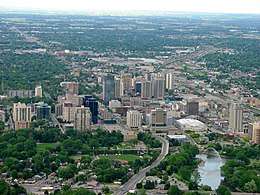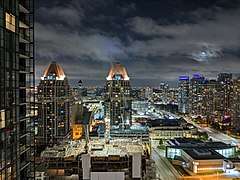List of cities in Ontario
A city is a subtype of municipalities in the Canadian province of Ontario. A city can have the municipal status of either a single-tier or lower-tier municipality. Prior to 2003, Ontario had minimum population thresholds of 15,000 and 25,000 for city status. Minimum population thresholds are no longer necessary for a municipality to brand itself as a city.
Ontario has 52 cities,[1] which together had in 2016 a cumulative population of 9,900,179 and average population of 190,388.[2] The most and least populous are Toronto and Dryden, with 2,731,571 and 7,749 residents, respectively.[2] Ontario's newest city is Richmond Hill, whose council voted to change from a town to a city on March 26, 2019.[3] Previous to that, Markham changed from a town to a city on July 1, 2012.[4]
History
Under the former Municipal Act, 1990, a city was both an urban and a local municipality.[5] Under that act, the Ontario Municipal Board (OMB) could change the status of a village or town, upon its request, to a city if it had a population of 15,000 or more.[5] The OMB could also incorporate a township as a city under the same conditions with the exception that the population requirements was 25,000 or more.[5] In either event, if located within a county, authorization by the Minister of Municipal Affairs was also required.[5]
In the transition to the Municipal Act, 2001, conventional municipal statuses and their associated population threshold requirements were abandoned. On December 31, 2002, every city that:[6]
- "existed and formed part of a county, a regional or district municipality or the County of Oxford for municipal purposes" became a lower-tier municipality yet retained its name as a city; and
- "existed and did not form part of a county, a regional or district municipality or the County of Oxford for municipal purposes" became a single-tier municipality yet retained its name as a city.
The current legislation also provides lower and single-tier municipalities with the authority to name themselves as "cities", or other former conventional municipal status types such as "towns", "villages" or "townships", or generically as "municipalities".[7]
Cities in Ontario
- Toronto is Ontario's capital and Canada's largest city
 Ottawa is Canada's capital and Ontario's second largest city
Ottawa is Canada's capital and Ontario's second largest city Downtown Brampton
Downtown Brampton- Skyline of downtown Hamilton
 Skyline of downtown London
Skyline of downtown London- Richmond Hill Centre for the Performing Arts in Richmond Hill, Ontario's newest city
.jpg) Vaughan as viewed from Canada's Wonderland
Vaughan as viewed from Canada's Wonderland- Downtown Kitchener
 Downtown Windsor
Downtown Windsor Downtown Mississauga
Downtown Mississauga
See also
Notes and references
Notes
- The Barrie census metropolitan area (CMA) is formed around the City of Barrie.
- Brampton is Canada's ninth-largest city.
- The Brantford CMA includes the City of Brantford as well as the County of Brant, which is a single-tier city.
- The City of Cambridge, as well as the cities of Kitchener and Waterloo, form parts of the Kitchener–Cambridge–Waterloo CMA.
- Dryden is Ontario's smallest city by population.
- Greater Sudbury is Ontario's largest city by area. The Greater Sudbury CMA is formed around the City of Greater Sudbury.
- The Guelph CMA is formed around the City of Guelph.
- Hamilton is Canada's tenth-largest city. The Hamilton CMA includes the cities of Burlington and Hamilton.
- The Kingston CMA is formed around the City of Kingston.
- The City of Kitchener, as well as the cities of Cambridge and Waterloo, form parts of the Kitchener–Cambridge–Waterloo CMA.
- The London CMA includes the cities of London and St. Thomas.
- Markham is Ontario's second-newest city, adopting the name on July 1, 2012.
- Mississauga is Canada's sixth-largest city.
- The City of Niagara Falls, as well as the cities of Port Colborne, St. Catharines, Thorold and Welland, form parts of the St. Catharines–Niagara CMA.
- The Oshawa CMA is formed around the City of Oshawa.
- Ottawa is Canada's capital and fourth-largest city. The Ontario portion of the Ottawa–Gatineau CMA includes the cities of Clarence-Rockland and Ottawa.
- Pembroke is Ontario's smallest city by area.
- The Peterborough CMA is formed around the City of Peterborough.
- Richmond Hill is Ontario's newest city, adopting the name on March 26, 2019.
- The City of St. Catharines, as well as the cities of Niagara Falls, Port Colborne, Thorold and Welland, form parts of the St. Catharines–Niagara CMA.
- The Thunder Bay CMA is formed around the City of Thunder Bay.
- Toronto is Ontario's capital and Canada's and Ontario's largest city by population. The Toronto CMA includes the cities of Brampton, Markham, Mississauga, Pickering, Richmond Hill, Toronto and Vaughan.
- The City of Waterloo, as well as the cities of Cambridge and Kitchener, form parts of the Kitchener–Cambridge–Waterloo CMA.
- The Windsor CMA is formed around the City of Windsor.
References
- "List of Ontario Municipalities". Ontario Municipal Affairs and Housing. September 21, 2012. Archived from the original on February 28, 2013. Retrieved January 3, 2013.
- "subdivisions (municipalities) and designated places, 2016 and 2011 censuses – 100% data". Statistics Canada.
- "Richmond Hill Becomes a City". RichmondHill.ca. Retrieved 27 March 2019.
- "Markham to change from town to city". CBC News. May 30, 2012. Retrieved January 3, 2014.
- "Municipal Act, R.S.O. 1990, Chapter M.45". Service Ontario. Retrieved June 29, 2013.
- "Municipal Act, S.O. 2001, Chapter 25". Service Ontario. Retrieved June 29, 2013.
- "The Municipal Councillor's Guide". Ontario Ministry of Municipal Affairs and Housing. Retrieved June 29, 2013.
- "Population and dwelling counts, for Canada, provinces and territories, and census subdivisions (municipalities), 2011 and 2006 censuses (Ontario)". Statistics Canada. May 28, 2012. Retrieved January 3, 2013.
- "Population and dwelling counts, for Canada, provinces and territories, and census divisions, 2011 and 2006 censuses (Ontario)". Statistics Canada. January 30, 2013. Retrieved June 27, 2013.